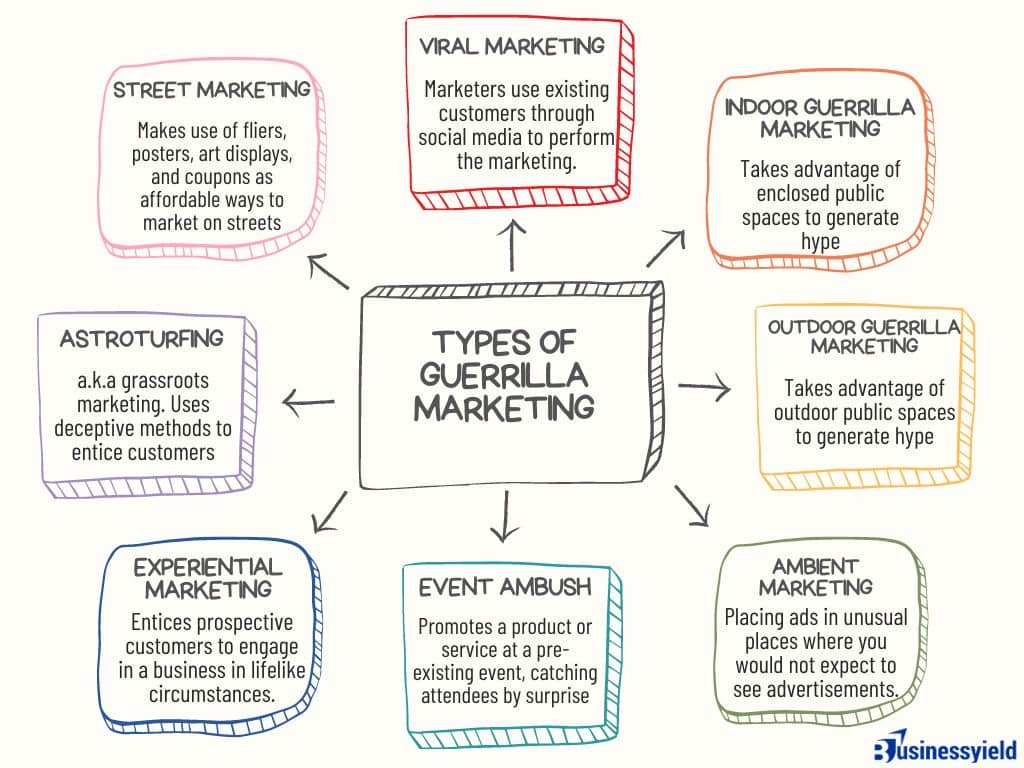What is guerrilla marketing?
If you are a war aficionado, you must have heard the word guerrilla before, which involves utilizing unconventional methods of combat. Rather than head-on confrontations, it focuses on ambush, sabotage, hit-and-run tactics, and petty warfare. In fact, the word guerrilla alone sounds intense, evoking images of rebellion and conflict.
So what’s this got to do with marketing?
Key takeaways
Guerrilla marketing is the creating use of novel or unconventional methods in order to boost sales or attract interest in a brand or business.
Typically, guerrilla marketing relies on human interaction in urban areas to create a big impact on a small budget in hopes of spreading by word of mouth and social media.
When executed successfully, guerrilla marketing’s ultimate goal is to scale up brand awareness on digital platforms.
What is guerrilla marketing?
Guerrilla marketing is a way to drive publicity and, as a result, brand awareness by promoting using unconventional methods designed to evoke surprise, wonder, or shock. It is an alternative to traditional marketing, such as print media, television commercials, billboards, and direct mail. Instead, it focuses on disrupting public spaces and events with unusual, memorable images or activities that may lead to brand association or purchase.
The term itself was created in the early 1980s by the late business writer Jay Conrad Levinson, who wrote several books about guerrilla tactics in several professional areas. It grew in popularity in the early 2000s, and since then, many ideas have been recycled. Today’s strategies must be extra fresh to compete for attention. These days, digital marketing has a higher return on investment (ROI) because it shows up where the consumers are—on the internet.
Typically, guerrilla marketing relies on human interaction in urban areas to create a big impact on a small budget in hopes of spreading by word of mouth and social media.
Guerrilla marketing takes place in public places that offer as big an audience as possible, such as streets, concerts, public parks, sporting events, festivals, beaches, and shopping centers. One key element of guerrilla marketing is choosing the right time and place to conduct a campaign so as to avoid potential legal issues. Guerrilla marketing can be indoor, outdoor, an “event ambush,” or experiential, meant to get the public to interact with a brand.
When executed successfully, guerrilla marketing’s ultimate goal is to scale up brand awareness on digital platforms.
Marketing Plan Checklist
Types of guerrilla marketing
Here are some types of guerrilla marketing tactics that you might want to try should you decide that this type of marketing is for you.

This type of guerrilla marketing encourages individuals to spread information about a product or service via the internet. Marketers deliberately use existing customers through various social media platforms to perform the marketing for them. Viral marketing can effectively create an image for your company, all through your existing customers, and through word-of-mouth.
Viral marketing can be implemented using many different avenues, such as a viral email campaign, videos, applications for mobile devices, and web pages.
One example of a successful creative marketing campaign in the past is Burger King’s subservient chicken, which required a person to dress up in a chicken outfit and perform any act that he/she was requested to perform.
After only one day, the subservient chicken resulted in one million people ordering the chicken to perform ridiculous and unheard-of acts, while simultaneously driving more business to Burger King in the process.
Indoor guerrilla marketing
Indoor guerrilla marketing takes advantage of enclosed public spaces to generate hype. This could include university campuses, train stations, or museums. In 2009, T-Mobile sponsored a flash mob at Liverpool Street Station that has over 40 million views on YouTube, won TV commercial of the year at the British Television Advertising Awards, and translated to a 52 percent increase in sales.
An example of this was when Frontline Fleas bought out floor space in a shopping mall and placed an image of an itchy golden retriever dog on it. Shoppers on upper floors who looked down saw a dog covered in “fleas” that were actually humans walking on top of the photo, oblivious that they were now part of Frontline’s advertising.
This ambient campaign worked because it made customers look twice, shocking them when they spotted the moving fleas and then delighting them when they realized those “fleas” were people.
Outdoor guerrilla marketing
Outdoor guerrilla marketing is the act of placing something unusual in an outdoor environment. This tends to be done in urban areas with plenty of foot traffic. Examples of outdoor guerrilla marketing include adding something to a statue, placing an oversized replica of a typically small object (like a cupcake) in a park, or putting objects in the streets (like IKEA’s sofas at bus stations in Australia).
When the brand GOLDTOE launched a new line of boxers and briefs in 2010, they dressed the New York City Stock Exchange bull in a giant pair of GOLDTOE underwear. This tactic worked because it was simple, silly, and memorable. While it was risky to take over an iconic public statue, the company did not damage the property and received media coverage for its cheekiness (pun intended), without spending a lot of money.
Ambient marketing
Ambient marketing is an extremely creative marketing strategy that works by placing ads in unusual places where you typically would not expect to see advertisements.
The sole purpose is to catch people off guard and encourage them to not only familiarize themselves with your brand but to also seek more information about obtaining your product or services.
Ambient marketing can be fun for the expert who creates it, as well as the people who see these ads because they’re made to grab a person’s attention, which is exactly what the right campaign can do. Ambient marketing is often done so strategically that even if an ad is in an unusual and unexpected environment, it’s done so tastefully that it appears as if it somehow fits.
One example of ambient marketing is an ad that Folgers, a popular United States-based company, implemented. Since New York City is referred to as the city that never sleeps, Folger’s placed an ad over a manhole that stated, “Hey city that never sleeps. Wake up.” This statement included a colored picture of a mug of black coffee that appeared to have steam coming from it, although, of course, the steam came from the manhole itself.
After the statement, there was a Folgers logo.
Event ambush guerrilla marketing
Event ambush guerrilla marketing promotes a product or service at a pre-existing event, such as a concert, sporting event, or festival, sometimes without permission. This type of marketing catches event attendees by surprise when something unusual occurs.
At the 2019 Golden Globes awards show, paparazzi took photos of celebrities posing on the red carpet, as is custom. Behind the unsuspecting movie stars, a model dressed in a dark blue dress holding a tray of Fiji Water photobombed nearly every shot. She stared directly into the camera for an unsettling effect. On the internet, the photos went viral, even generating a spoof Twitter account.
Experiential marketing
If your goal is to grow your audience, which is the goal of many business owners, you might want to try experiential marketing. Also known as “engagement” marketing, this form of marketing intends to entice prospective customers to engage in a business in lifelike circumstances.
Experiential marketing requires that audiences become so involved with the business’s ad campaign that participation and even hands-on involvement is encouraged. The goal of this type of marketing is to prove to their target audience what they represent, and not merely what they have to offer.
One company that has implemented many successful experiential marketing ads is M&M. From tasting rooms to the “Great Color Quest,” and much more in-between, M&M has had some of the most unique experiential marketing campaigns that target audiences found quite memorable since it required them to participate in and actually taste up and coming flavors of these popular candies.
M&M remains one of the most popular brands since making its debut more than eighty years ago in 1941.
For experiential marketing campaigns to be successful, they must be strategically planned by creative and experienced marketers. These campaigns must be fun and attractive so that a target audience won’t be able to resist participating in these affairs. If implemented properly, experiential marketing can effectively reinforce a long-term connection between the target audience and a particular brand.
Astroturfing marketing
Astroturfing is sort of a deceiving type of guerrilla marketing, and it’s also known as grassroots marketing. In this type of guerrilla marketing, the marketing experts go to great lengths to appear as if they’re from natural sources, while strategically concealing the name of the brand.
Astroturfing can be implemented in several ways, one of which is to create phony social media profiles. These phony profiles are then used to bash the competition while raving about the brand at hand. Another way to implement an astroturfing campaign is to make it appear as if customers prefer a certain brand, yet these “customers” have been paid in advance to carefully play their part in the facade.
Due to how astroturfing is implemented, it is often considered to be one of the most unscrupulous guerrilla marketing strategies out there. It certainly has the potential to be successful, but if the public discovers the truth, then the consequences may not be so pleasant.
For instance, many companies have been sued and fined for deceiving their target audience. If you search the web for court cases regarding popular brands experiencing their astroturfing marketing backfiring on them, you will likely find plenty of information.
Major brands have had negative experiences with this type of marketing. Parents have even sued schools for using astroturfing as a means to promote their schools of choice.
Street marketing
This is a type of guerrilla marketing that focuses on using unconventional manners in which to market a brand.
Instead of using traditional marketing like television and radio ads as many brands do, those with street marketing campaigns often opt for the use of fliers, posters, art displays, and coupons as affordable ways to market themselves. Street marketing received its name because its marketing campaigns are literally implemented on busy streets and/or in or near shopping centers.
However, these alternative forms of advertising aren’t always the types of ads that people expect. In fact, companies have been accused of being unethical with their street marketing ads, because they often contain some extreme and outrageous material. Some of it is even insulting or scary. Even though it’s been touted as being unethical, street marketing is effective in many cases, which is why it’s still a popular guerrilla advertising strategy.
Some street guerrilla marketing examples are as follows:
- Flashmob: This entails a group of individuals who gather on a busy street and perform some type of entertaining dance or simply stand “still,” before quickly scattering away.
- Impromptu concerts: This entails a group involved in the ad campaign performing a spontaneous concert on a busy street or inside or near a well-populated mall.
- Street art: Urban paintings and sculptures have been a popular way to advertise for years, and they continue to attract the attention of new prospective customers.
- Games, contests and tests: These types of activities are intended to involve the public, as it is an integrated marketing strategy. The more outrageous the topic or theme is, the more of a rise the brand will receive, which they hope is positive.
Pros and cons of guerrilla marketing
Guerrilla marketing is unique in how it interacts with customers in surprising and participatory ways, but the tactic can come with some potential risks. If you choose to employ guerrilla marketing for your brand, keep these pros and cons in mind:
| Guerrilla marketing pros | Guerrilla marketing cons |
|---|---|
| Spend less: Guerrilla marketing can be effective even on a low budget. | Risk failure: The brand is put on public display, which can backfire if a poorly executed campaign flops. |
| Have fun: You get to be creative and generate unusual ideas to build a brand. | Risk loss: You could lose money or profits if unforeseen circumstances arise, such as bad weather or political tensions. |
| Gain insights: Based on people’s reactions, you can better understand how they feel about the brand. | Embarrass or frighten an audience: Some forms of guerrilla marketing employ ambushing, filming, or scare tactics that might embarrass or frighten people. |
| Go viral: Your campaign could get shared on social media (either by the brand or by participants) for maximum exposure. Media outlets may also generate attention. | Risk controversy: You might run into legal issues or negative publicity, depending on the outcome of the campaign. |
| Build partnerships: You may be able to develop a mutually beneficial partnership with a venue, organization, park, festival, or another brand. | Lose stakeholder approval: If a campaign is too risky or unconventional, it may not get approved by executives who would rather spend marketing dollars on more reliable strategies. |
Guerrilla marketing examples
Samsung’s Capture The Night Campaign
To promote the launch of the new Galaxy S23, Samsung launched its Capture The Night campaign, which served to bridge the gap between creativity and technology. Originally titled “Captura la noche” for its Argentine users, Samsung showed how much love and appreciation its users had for music as a way of life, as an intimate language, and as a coping mechanism.
Samsung created a web platform where its users could upload their night photos taken with Samsung Galaxy S23’s unparalleled night camera. This platform analyzed the photos and used AI algorithms to define the style of music for each photo.
Not only could Samsung users figure out the kind of music they’d like to listen to, but they could use the platform’s suggestions to create original songs of their own, just like Agusto Schuster did.
The big takeaway: Figure out something your target audience loves and find a way to give it to them through your campaign.
KFC Crocs
Do you love KFC’s world-famous fried chicken? Now, do you like Crocs? If your answer is yes to both questions, then you’ll understand the genius behind KFC’s decision to partner with Crocs.
In 2020, KFC and Crocs released limited edition Clogs featuring a realistic Kentucky Fried Chicken pattern and the recognizable red-striped bucket. The two Clog versions — the heeled and the regular — came with detachable drumstick-shaped Jibbitz charms attached to the top.
Beauty icon Me Love Me A Lot (MLMA) debuted the heeled version of these KFC x Crocs clogs at New York Fashion Week, one of the world’s most significant fashion events. This garnered a lot of attention, which led to the limited edition Clogs selling out in less than an hour after the official release.
For every pair sold, KFC donated $3 to the KFC Foundation’s Reach Educational Grant Program, which helps KFC employees get college scholarships.
The big takeaway: To get as many eyes as possible on your guerrilla marketing campaign, launch it at a big event. You can also incentivize people to buy your product by making donations or doing some charity work that you love.
Or you can do both, like KFC and Crocs.
Burger King’s Moldy Whopper
I’m pretty sure that whoever suggests the idea of a rotten burger for the face of a fast food ad would receive a lot of questioning looks from around the table. Well, someone definitely did at Burger King, and managed to convince the higher-ups to release a time-lapse video of their Whopper burger decaying for 35 days.
Many people complain about how near-perfect burgers and cereal look in ads. So what did Burger King do? The exact opposite, to show how successful they were at removing artificial preservatives from the Whopper sandwich in European countries and the United States.
The images show the mold growing over the burger, from the buns to the freshly sliced tomatoes, lettuce, and onions to the juicy beef patty. The ad also contained a reference to the number of days that have passed since the burger was made. And underneath, a statement read, “The beauty of no artificial preservatives.”
While it may seem very gross, the target audience did appreciate the ad’s message, and some even admitted that they’d choose the Whopper burger over others.
The big takeaway: Don’t be afraid to go to the extreme when marketing your products using guerrilla marketing tactics. It just might have the effect you want. Be cautious — but don’t be afraid.
BBC’s Dracula Billboard
What comes to mind when you think of Count Dracula? Well, I, for one, imagine the penultimate villain synonymous with everything that goes bump at night. This was the exact feeling that the BBC wanted to capitalize on to promote their show Dracula.
By day, their billboard was designed to be minimalistic, with red text on a white background with a few bloody stakes. However, like its subject, the billboard changed completely every time night fell. The stakes were strategically placed to cast a shadow of Dracula himself.
The installation was featured in Adweek and had some viral success for its creativity and skillful implementation.
The big takeaway: Think outside the box for your advertising materials. In this case, light and shadow were enough to convey the message and capture attention.
Budweiser’s Reunited With Buds Campaign
The spread of COVID-19 made 2020 a challenging year for everyone, including brands like Budweiser that aim to bring people together for a good time. So, to celebrate the reopening of bars, Budweiser launched their Reunited with Buds campaign, which focused on uniting people after a challenging year.
In the ad, Budweiser’s adorable Labrador retriever puppy and its famous Clydesdale horses each make long journeys to meet up, presumably after spending the past several weeks social distancing. With the Queen’s “Don’t Stop Me Now” playing in the background, the Reunited with Buds ad celebrated the excitement that comes with family, friends, and colleagues being able to grab a drink at the closest bar again.
In addition to accurately portraying the excitement of reopening, Budweiser displayed its product positively through balanced storytelling and nostalgic music.
The big takeaway: It’s okay to get a little sentimental and fill your guerrilla marketing campaign with elements that invoke powerful (and feel-good) emotions in your audience.
How to know if guerrilla marketing is right for your brand
Guerrilla marketing can leave a lasting and emotional impression on your target market. However, it can also backfire if it is not well executed. Here are some questions to help you decide if this tactic is right for your brand:
- Do you have a fun, original idea for engaging or surprising potential customers?
- Does your idea leverage the local space or culture in a respectful way?
- Can passersby participate in your campaign? How?
- Is the idea aligned with your brand positioning? What is the purpose of the message you want to send?
- Is it legal? Is it controversial?
- Will you be able to document and measure your campaign’s results?
- Does it have the potential to go viral?
Once you consider the potential risks and ROI, you may be ready to launch a guerrilla marketing campaign. Typically, guerrilla marketing works best for bigger brands that target a specific location and rely on word of mouth to spread the campaign nationally or globally. However, small local brands can also pop up at events to boost credibility.
No matter the industry, guerrilla marketing can be a low-cost way to delight potential customers and enhance other marketing efforts, such as display advertising and social media marketing.
Recommended Articles
- Top 88 Marketing Tools & Expert Tips for 2024: A Guide to Digital Dominance
- What Is SEM? Your Crash Course On Search Engine Marketing And Why It Matters
- Inside Sales vs Outside Sales: Ways to Balance the Roles for Growth
- What the Challenger Sales Model Is and How to Use It for Better Outcome
- A Guide to Implementing Prestige Pricing Strategies for Business Owners
- Price Lining: What It Is and Strategies for Effective Implementation






